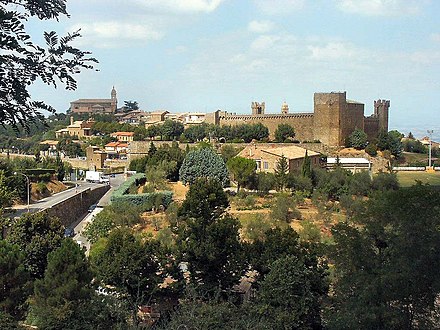

El vino es una bebida alcohólica que se elabora a partir de la fermentación del jugo de uva . El equilibrio químico natural de las uvas es tal que pueden fermentar sin la adición de azúcares , ácidos , enzimas u otros nutrientes . Aunque también se pueden fermentar otras frutas además de las uvas, los vinos resultantes normalmente reciben el nombre de la fruta de la que se producen (por ejemplo, vino de manzana ) y se conocen como vino de frutas (o vino de campo). Otros, como el vino de cebada y el vino de arroz (por ejemplo, el sake ), se elaboran a partir demateriales a base de almidón y se parecen más a la cerveza que al vino; el vino de jengibre se fortifica con brandy . En estos casos, el uso del término "vino" es una referencia al mayor contenido de alcohol, en lugar del proceso de producción. El uso comercial de la palabra "vino" (y su equivalente en otros idiomas) está protegido por la ley en muchas jurisdicciones . El vino se produce fermentando uvas trituradas utilizando varios tipos de levadura que consumen los azúcares que se encuentran en las uvas y los convierten en alcohol . Dependiendo del tipo de vino producido se utilizan distintas variedades de uvas y cepas de levaduras.
El vino tiene una larga y rica historia que se remonta a unos 8.000 años y se cree que se originó en la actual Georgia o Irán . Se cree que el vino apareció en Europa hace unos 6.500 años en la actual Bulgaria y Grecia y era muy común en la antigua Grecia y Roma ; el dios griego Dionisos y su homólogo romano Liber representaban el vino. El vino sigue desempeñando un papel en las ceremonias religiosas, como el Kiddush en el judaísmo y la Eucaristía en el cristianismo . ( Artículo completo... )











Tenuta Dell'Ornellaia fue fundada por el marqués Lodovico Antinori de la familia Antoniori , responsable de una de las firmas negociantes más históricas de Italia, con la ayuda del enólogo Tibor Gál. La propiedad está adyacente a Tenuta San Guido, productor de Sassicaia y considerado el seminal Super Toscano, y Ornellaia fue sugerido como la respuesta competitiva de Lodovico Antinori al Sassicaia de su primo Nicolò Incisa y al Solaia de su hermano mayor Piero Antinori . Los viñedos de la finca Ornellaia se plantaron en 1981, produciendo la primera cosecha en 1985. Se construyó una bodega moderna en 1987, y más tarde se agregó una segunda propiedad de 56 hectáreas, Bellaria, situada al norte de Bolgheri. ( Artículo completo... )

Los siguientes proyectos hermanos de la Fundación Wikimedia proporcionan más información sobre este tema: